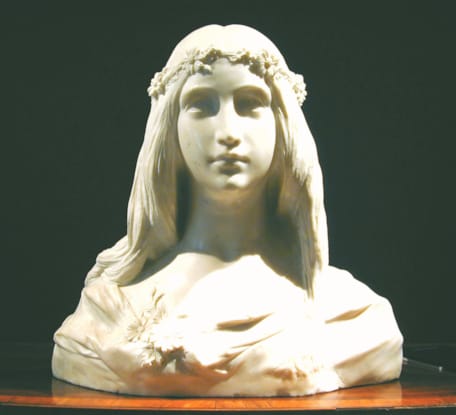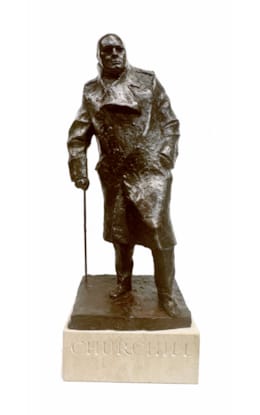John Adams-Acton
(1830 - 1910)
Ruth Amid the Alien Corn
Signed, J. Adams-Acton/Fecit and inscribed
RUTH – WHEN SICK FOR HOME / SHE STOOD IN TEARS AMID THE ALIEN CORN
White marble, height 39¾ in – 101 cm
White veined column, height 37¾ in – 96 cm
RUTH – WHEN SICK FOR HOME / SHE STOOD IN TEARS AMID THE ALIEN CORN
White marble, height 39¾ in – 101 cm
White veined column, height 37¾ in – 96 cm
Tel.: +44 (0)20 7839 7693
Provenance
Stokesay Court, Shropshire;
Private collection, UK;
MacConnal-Mason Gallery, London, 2006;
Private collection, UK
Private collection, UK;
MacConnal-Mason Gallery, London, 2006;
Private collection, UK
Biography
John Adams was born in Acton, Middlesex, the son of a tailor in 1830. He studied at Lady Byron’s School in Ealing and subsequently as a sculptor in the studios of Timothy Butler and Matthew Noble (1818-1876). He studied at the Royal Academy Schools 1853-58 as a sculptor and medallist, first exhibiting at the Royal Academy in 1854 at the tender age of twenty. By 1858, Adams had moved from the family home in Acton to Trevor Square in Knightsbridge moving that same year to Rome, where he continued his studies with John Gibson (1790-1866).
On his return from Rome, Adams turned towards sculpting in marble, in addition to his medallions in bronze; Adams rapidly developed a highly successful career in portraiture, sculpting eminent contemporaries, including the future Prime Minister W. E. Gladstone MP in 1865. Adams also produced biblical, mythological and literary subjects, “Ruth”, “Abel’s Sacrifice”, “Orestes and Pylades” and “Ellen, Lady of the Lake”.
In 1869, John Adams added Acton to his surname, no doubt to distinguish himself from the two painters named John Adams, also RA exhibitors. His career continued apace, Adams-Acton moved to Marylebone, accommodating his sister Clarissa Adams, also a sculptor, who exhibited 1870-77 at the Royal Academy and in 1882 Adams Acton moved to Abbey Road in St. John’s Wood, home to so many of the successful and affluent artists of the Victorian period including Alma Tadema and Tissot. Adams-Acton continued to sculpt portraits of the successful and influential, including Gladstone once again, Earl Russell, the MP’s Sir Wilfred Lawson and the Earl of Shaftesbury and Charles Dickens. In a tribute to his standing as a sculptor, Adams-Acton also portrayed numerous artists, including Frith, Landseer, Horsley, Calderon, Faed and Marks.
Adams-Acton was a member of the Society of British Artists and one of the foremost British sculptors of the period.
His works can be found in museums in: London, The National Portrait Gallery.
On his return from Rome, Adams turned towards sculpting in marble, in addition to his medallions in bronze; Adams rapidly developed a highly successful career in portraiture, sculpting eminent contemporaries, including the future Prime Minister W. E. Gladstone MP in 1865. Adams also produced biblical, mythological and literary subjects, “Ruth”, “Abel’s Sacrifice”, “Orestes and Pylades” and “Ellen, Lady of the Lake”.
In 1869, John Adams added Acton to his surname, no doubt to distinguish himself from the two painters named John Adams, also RA exhibitors. His career continued apace, Adams-Acton moved to Marylebone, accommodating his sister Clarissa Adams, also a sculptor, who exhibited 1870-77 at the Royal Academy and in 1882 Adams Acton moved to Abbey Road in St. John’s Wood, home to so many of the successful and affluent artists of the Victorian period including Alma Tadema and Tissot. Adams-Acton continued to sculpt portraits of the successful and influential, including Gladstone once again, Earl Russell, the MP’s Sir Wilfred Lawson and the Earl of Shaftesbury and Charles Dickens. In a tribute to his standing as a sculptor, Adams-Acton also portrayed numerous artists, including Frith, Landseer, Horsley, Calderon, Faed and Marks.
Adams-Acton was a member of the Society of British Artists and one of the foremost British sculptors of the period.
His works can be found in museums in: London, The National Portrait Gallery.





_2832024T11614.613.jpg?width=550&height=415&format=jpg&quality=80&mode=max)
